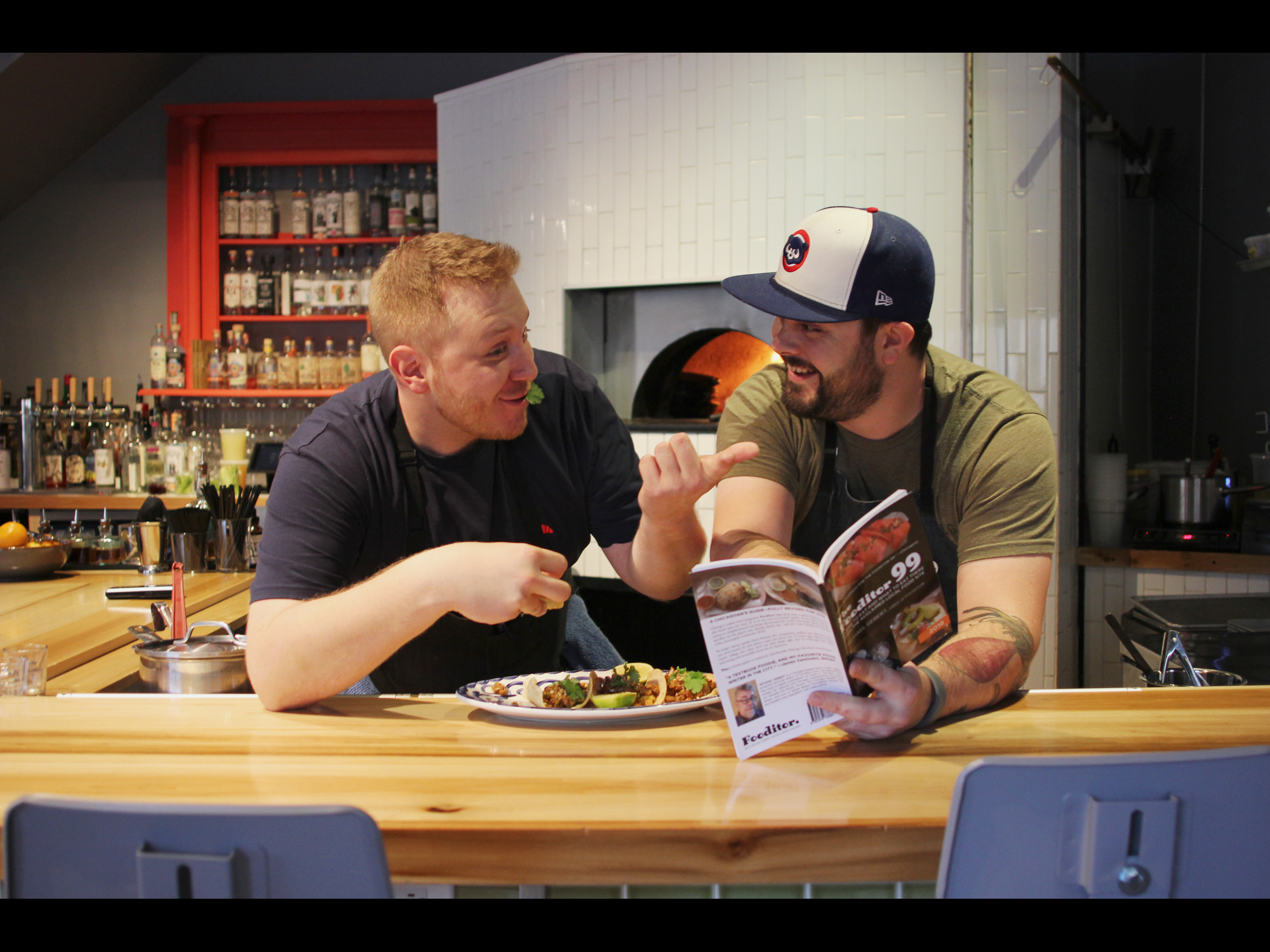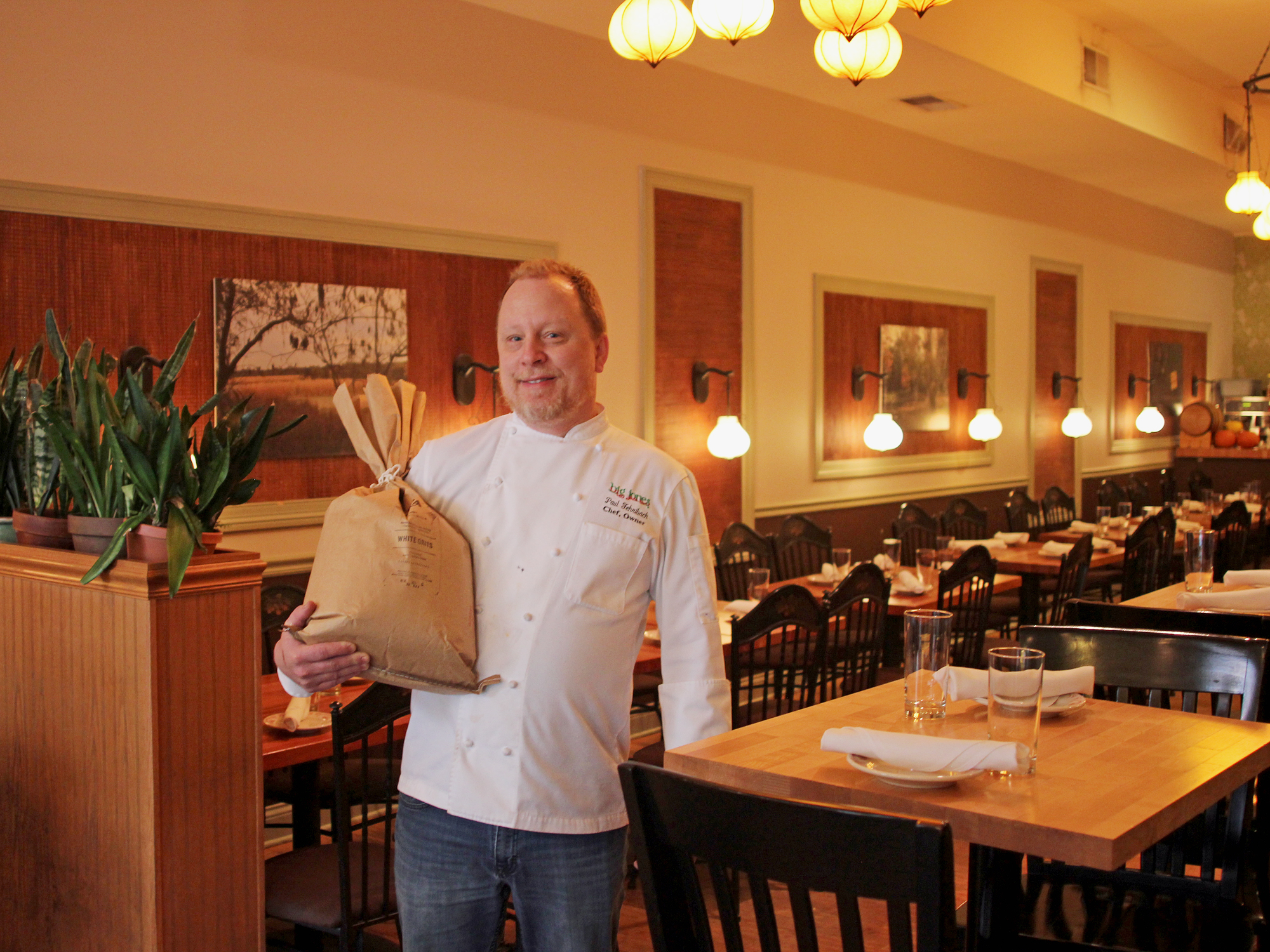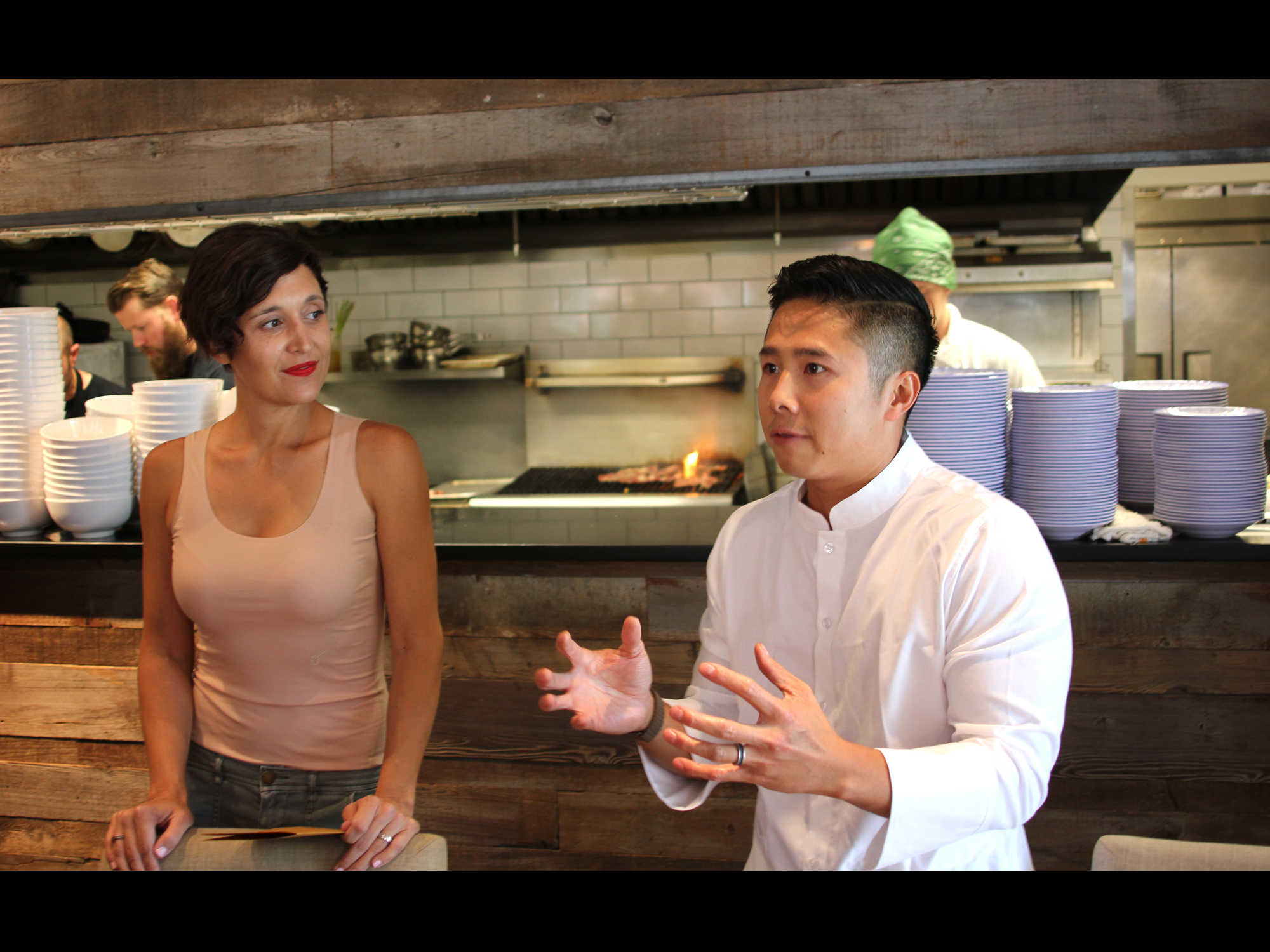STEPHEN GILLANDERS’ S.K.Y., IN PILSEN, GOT THE WRONG start from an opening restaurant’s point of view. Gillanders had a good backstory—the managing chef of Lettuce Entertain You’s now-closed Intro, a veteran of Jean-Georges Vongerichten’s organization, opening his own place with a strong Asian influence (he’s part-Filipino and his wife is Korean).
But instead of encountering his restaurant for itself, we were introduced to it at the center of a controversy. A group of anti-gentrification protesters, only some of them actually from Chicago, shared a video of their confrontation with manager Charles Ford outside the yet-to-open restaurant.
Well, S.K.Y. has opened now and it deserves to be known in more ways than by that news story alone. In many ways S.K.Y. was a bit of a red herring for this kind of protest—yes, it’s probably the poshest thing besides Acadia to exist south of Roosevelt in Chicago, and part of a mini new restaurant row that includes HaiSous and Dusek’s Board & Beer, alongside longtime Pilsen spots such as Azul 18 and La Catrina Cafe.
But it’s not that expensive, far below the price level of any restaurant with Jean-Georges’ name on it, and it’s not a big chain dropping down into a neighborhood. It’s a mom and pop, same as the taquerias and carnitas places along 18th—built by Gillanders and his wife, who designed it on the chicly cheap. And talking to him, it becomes clear that it comes out of a sincere desire to be part of a neighborhood he bonded with, offering an accessible dining experience and contributing to an arty, definitely food-oriented part of the city.
After just a few days of actual service around Thanksgiving, I sat down with Gillanders to talk about how he and S.K.Y.—which he originally planned to open in Los Angeles—got to the south side of Chicago. Toward the end of our conversation, Ford joined us to offer his insights on how they’ve reacted to the issues raised in the protest. Be sure to check out the short preview of the food, too—which is what they hope S.K.Y. will mainly be known for, soon.
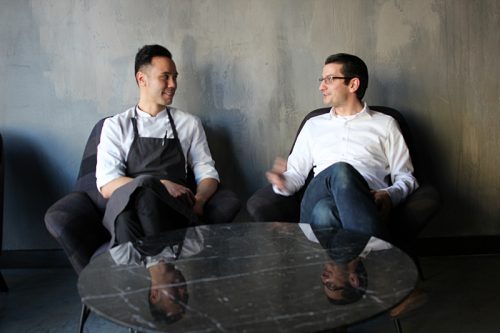
Chef Stephen Gillanders and manager Charles Ford
1. Where the name comes from
It’s my wife’s initials, her name is Seon Kyung Yuk. Without her this whole thing wouldn’t have happened. It really says that she’s part of the restaurant as much as I am.
She designed the restaurant, and she’s not a designer, she just has good taste. There were certain things that she decided to do to make it look like this, without having it so people would have to pay for the decor. We have things starting at seven bucks, and we have one item at $28 and that’s it. People always ask where the name comes from, and it’s an opportunity to tell that story, that this is really a very small venture.
2. Why they chose to open in Pilsen
There were a couple of locations that we looked at. Unfortunately, when I was at Intro, I lived in the building. Which was great and also awful—my entire life was focused on a four-block radius. I would go to Mon Ami Gabi [in the same building] three nights a week, and eat family meal the rest of the time. Or I’d go into the restaurant to check on things… and ten hours later my wife is eating Chinese food by herself.
I had a real estate agent come into Intro and send me a note thanking me for how much he enjoyed it. I asked him if he did any commercial restaurant space, and he did, and he said where do you like? I said I had no idea. So we got in his car and literally drove around the city for six hours.
When we got here, I loved this place. We actually had lunch at Dusek’s and he said, well, that’s a space over there, Honky Tonk BBQ is down the street, Thai Dang [HaiSous] just signed down the street, they’re putting a Furious Spoon in. And the neighborhood seemed very different from every other area that we looked at. When you get the full Chicago experience, Pilsen is its own thing for sure.
I really liked the area, I thought that the potential was good, I loved the arts studio feel of the neighborhood. I brought my wife down and she loved the space. She also thinks the space represents the food well, in terms of being understated and not going too far. We didn’t want to be another restaurant in the West Loop. Not only because financially we weren’t able to do it, but I don’t come from that world—when I was in New York I preferred going to Brooklyn to eating in Manhattan. I felt like we could be more true to ourselves here than anywhere else.
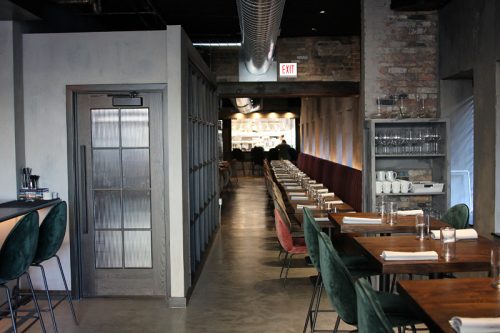
S.K.Y.
3. Working for Jean-Georges
I grew up with him, and I definitely grew up in that fine dining world. The problem was, at the end of the day I didn’t crave that food. I always tell people, you know you have something delicious when you want to take home the leftovers. And there have been a number of times when I’ve been like, there’s two bites of caviar left, and the thought of taking that home is asinine.
And the things that we want to eat when we get out of here are never, oh man, I could use a big slab of foie gras right now. So as much as I love Jean-Georges, and I am a direct reflection of that culture, I wanted to cook food that I wanted to eat, as opposed to food that I wanted to taste.
What Jean-Georges taught me was more to enhance than to manipulate. To start with an amazing product, and to add to it, and make it better—and then stop.
I think people who know Jean-Georges’ food intimately will look at what I’m doing and say, oh yeah, I can see how this guy came out of there. When I cooked for Rich Melman, I did a tasting for him. He was very difficult to read, and I think he does it on purpose. And I said, I worked for Jean-Georges for a decade, and unfortunately I think I cook like him. And Rich said, “I agree.” And I remember thinking, oh, that sucks. And he said, “That’s a good thing. Saying you cook like Jean-Georges is like saying you play basketball like Michael Jordan.”
And when he put it that way, I came to embrace it. But what we didn’t want was the Jean-Georges name to scare people away—oh, this is going to be the caviar-foie gras-truffle night. What Jean-Georges taught me was more to enhance than to manipulate. To start with an amazing product, and to add to it, and make it better—and then stop. Not to turn it into a mousse that you’re going to pipe into a toothpaste tube.
So we’re sort of applying those techniques to more affordable and approachable ingredients. And therefore, enhancing the experience and making things more valuable through technique, as opposed to through opulence. There was a dish that I had in Tokyo when I was opening a restaurant there, a sashimi dish that had this caviar dressing all over, and it was spectacular, but there was no way that we could land that here. So instead we decided to simmer black sesame seeds till they were soft and popped, to emulate that effect. You still get the idea of it, without having to pay $80 for two ounces of food.
4. Gallery: Dishes at S.K.Y.
Photos by Michael Gebert
5. How the first few days of service went
The first service we had, I didn’t know what to think. I opened 11 restaurants for Jean-Georges, so it’s not my first rodeo. But it’s the first time I had to worry about so many other things. And the menu mix—you never know. You always end up prepping things that you’re not selling. We trimmed down the menu a little bit, based on some stars and dogs.
But it went well. Scarily well. Charles and I were like, what are we not seeing that’s going wrong?
6. Opening up in Chicago
I originally came out here when Jean-Georges opened The Pump Room, six and a half years ago or whatever it was. And I had never really been to Chicago in that capacity, and I was living in the hotel for several months and I had an expense account, which enables you to actually go out and eat. I went to eat on Randolph Street—I went to The Publican, Girl and the Goat had just opened, and Jean-Georges was like, “What the fuck is she doing over there, is she crazy?”
But I’m like, the food here is incredible. My mentor, Greg Brainin, he’s the director of creative development for Jean-Georges, said Chicago was the best food city in America. And so when I was ready to open, he said, “How do you feel about opening in the best food city in America?” And I said, “Thanks, when you put it that way…”
I feel like chefs should cook the food they want to cook. In New York, we had to cook for Manhattanites. And the second you don’t have tuna tartare on the menu, you will close. So you start to cook very un-genuinely.
Here, not only can you cook what you want, people want you to do that. And the clientele and the population here is so much more supportive of the industry. They’re not looking to just crush people. It’s not just baller cuisine, though that does exist and it’s great that you can go from, say, La Pasadita to The Publican to Alinea within a few mile radius.
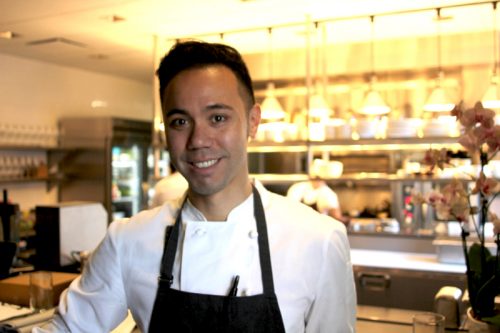
Chef Stephen Gillanders
7. On trying out his dishes at Intro
Intro, of course, was this revolving chef concept where people would come in, they would showcase themselves—and then there was me [as managing chef and author of the menu to which the guest chef’s dishes were added]. We were planning on opening S.K.Y. in Los Angeles, so the entire reason we went to Intro was to do S.K.Y. there, get it built exactly—and then move it.
But cooking for Chicagoans is very different from cooking for New Yorkers or cooking for Los Angelenos. The hamachi dish on our menu now, we ended up cleaning it up at Intro, it was a lot busier before. We made it a little less fussy, a little less garnished, and sort of focused it on the purity of everything else. I found that most of the successful dishes at Intro were the ones that went along that line. Intro taught me how to edit a lot. There are dishes here that might be familiar [to diners at Intro], but they’re at the top of their game. We hit a certain point, and then we stopped.
And the cooks have a hard time because—like we sold 30 lobster dumplings on Saturday. And the guy picking it up is over it [laughs]. He’s like, let’s do something else. No, you have to remember how it tasted the first time you had it. Because 95% of the people who are going to be here are only going to have it once.
8. Fusion is the F-word
The restaurant is modern American, travel inspired. The term “modern American” is such a crapshoot now—it doesn’t mean anything. The one thing that it does tell people, though, is that it’s kind of casual. It’s not French service.
Only three of the restaurants I opened for Jean-Georges were in the states. My last year, I traveled 301 days out of the year, which is a lot. And we just wanted to make sure that the food was reflective of the food that I had then. Like, I was in Tokyo, and I had the dish that inspired the hamachi dish on the menu there—the otoro with the caviar sauce. And I was like, this is so fuckin’ good, I have to do something like it.
Whenever I was traveling, the best dishes I had, I was so enamored by them, I just want to make food like this, I want something to eat like this, whether it’s a shrimp dumpling in Beijing, or a sashimi dish in Tokyo, or fresh lobster in St. Bart’s. The problem is, though, that’s not a restaurant. I want to pull from my travels, but still make it cohesive. Because the last thing we want to do here is fusion confusion. I tell everyone here, do not use that word, that is the F-word and you’re not allowed to use it.
It’s inspired by the places I’ve been and the travels I’ve had, which makes it really personal. Now, no one knows what Stephen Gillanders’ food is, so if I said that, they’d be, that’s great, get over yourself. But we’re trying to forge a style of our own, and to say that it doesn’t lean Asian would be a fallacy. My mom’s Filipino, my wife’s Korean, the majority of the restaurants that I opened for Jean-Georges were in Asia. Three in Shanghai, one in Tokyo, we went to Singapore every year, so a lot of my inspiration comes from that part of the world—and they do a very good job of taking simple things, and making them great.
9. Being the target of protesters
STEPHEN: If anything I think it strengthened the bond that we have with the community. The day that we got vandalized did suck, 6:45 in the morning, it’s 30 degrees out and we’re cleaning paint off our window, we hadn’t even opened yet. But then the response from the community was so overwhelmingly positive that it made everyone closer. It opened up opportunities for dialogue that we wouldn’t have had otherwise. I wish it could have been done a little bit differently, I wish we could have just walked up to somebody and said hi, but if that’s what it took for people to see that we’re not that, then it was worth it.
I don’t think that group has ever been back. We still get a little pushback.
CHARLES: We get a call every once in a while, people who want to badger us about the check average or something like that. We get people who will come in and kind of, how do you say—
STEPHEN: Mock the menu.
CHARLES: Yeah. But from our point of view and the staff’s point of view, we’re just trying to take the high road, set the example. We have people who work in this restaurant from all over the city. A lot of them happen to be from Pilsen, actually. And we did that without even actually knowing it, to tell you the truth.
STEPHEN: Yeah, one guy walked in and filled out an application and then walked out the door and into his home right over there.
CHARLES: And we found out that the opinion of those people who decided to tag us, and who decided to come in and protest, that’s not the opinion of the neighborhood. And on that note, it feels good.
But it represents this kind of lingering challenge on the horizon, that it’s going to take an effort from the entire crew, every single day that we come in. I think Pilsen as a neighborhood, more than any other in Chicago, holds its residents accountable to chip in, to do what they need to do to make the neighborhood better. And we’re right here ready to do that.

STEPHEN: Ultimately, we’re good people, and that will show. I think what happens is that a lot of times, the assholes come through, and it puts everyone into that pile. Eventually I think as everyone gets to know us and understands that we’re not that way, and that we do have a desire to not only be in this neighborhood but be part of it and contribute to it, everybody will realize that these guys are okay.
We met with a group a couple of weeks ago, and I said, wouldn’t it be great if we became the standard? That you can come in and you can open your restaurant that quote-unquote doesn’t fit in, but you can still be a huge asset to the community, you can provide jobs and opportunities and resources. Now people who don’t live in Pilsen are coming in [to the restaurant] and providing support for the community. We donate to the Pilsen Farmers Market, we volunteer at Kitchen Possible, which teaches kids how to cook.
It just needs to get out. People need to realize that we’re not this huge corporation who’s looking to just Columbus everything.
CHARLES: We’re aware of who we are. We’re not as inexpensive as the taqueria or the diner down the street. But we’re saying, if you want to have a nice dinner, at an affordable cost, you can do that here. And a lot of people from this neighborhood have said, thank you.
STEPHEN: We’re starting this thing on Mondays, for the community, for people who don’t feel comfortable walking in, they can just come in for a cup of coffee and hang out in the lounge, we’ll have some pastries for them. So if you don’t feel comfortable walking in for dinner, you can just come in and meet us. And find out that, these guys are cool. We’ll wave when you walk by the kitchen.
Michael Gebert is a red herring for the real editor of Fooditor.
Latest
Join the Discussion
After you comment, click Post. If you're not already logged in you will be asked to log in or register with Disqus.









